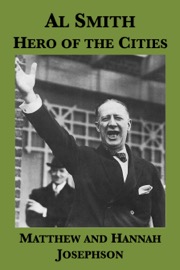 $9.99 on Kindle
$9.99 on KindleAl Smith: Hero of the Cities (A Political Portrait Drawing on the Papers of Frances Perkins) by Matthew Josephson and Hannah Josephson (145,000 words; 18 illustrations)
Al Smith (1873-1944) was born and grew up in New York’s Lower East Side slums and got his start in politics under Tammany Hall sponsorship. Frances Perkins was a New Englander, a trained social worker who became a public figure when Smith appointed her to the New York State Industrial Commission. They shared a concern for working people and a love for the Empire State, which Smith served as governor for four precedent-breaking terms between 1919 and 1928 after serving in the New York State Assembly between 1904 and 1915 as a member and later as Speaker.
Smith considered himself an Assemblyman. His record as governor is based on the solid understanding of politics he acquired in those years. It was also fostered by his encounter, at a decisive stage, with a group of reformers and social workers, including Belle Moskowitz who became his chief political strategist. Smith’s own great contribution was to show how reform could be made practicable.
As governor, Smith fought a running battle with an obstructive legislature; he was able to reorganize New York State’s sprawling executive departments, protect women and children in industry, strengthen workmen’s compensation laws and shorten their working hours, stop the handouts of state resources to private companies, and expand recreational areas for the benefit of the public. He cut taxes while building hospitals, schools and low-cost housing developments. When the legislature balked, he appealed to the people on radio, and they responded with avalanches of letters and telegrams to their representatives. The dauntless spirit with which he battled his adversaries earned him the title “The fighting Governor.”
After his defeat for the Presidency in 1928, Smith was able to hand on to his successor — a comparatively inexperienced politician named Franklin D. Roosevelt — a working state government and a blueprint for social reform which Roosevelt would put to good use.
At the time of her death in 1965 Frances Perkins was working on a book about Al Smith as she knew him. Her notes, the few chapters she had written, and the oral history she recorded for Columbia University were turned over to Matthew and Hannah Josephson, who used them and their own exhaustive research to write this biography.
“The Josephsons, both authors in their own right... were invited to complete the unfinished biography of Smith that Frances Perkins left behind at her death in 1965. Finding only a rather bare start, they ended up writing it ‘90%’ themselves... The sections on Smith’s early years provide a delightful picture of the Old East Side and a thriving Tammany Hall... A happily executed portrait of an eminent and engaging American.” — Kirkus Reviews
“The most thorough study yet available of Smith’s career, and one that also pays considerable attention to Frances Perkins’ contributions to reform during the Progressive period and during Smith’s gubernatorial administrations... [a] useful biography of Al Smith.” — Joel A. Tarr, The American Historical Review
“The book reflects the warmth and vigour of its subject... The book’s principal contribution is its emphasis on Smith’s tremendous effectiveness both as a party leader and as a reformer. His quarter-century of almost continuous success was founded on exceptional memory, intense application, a sharp wit and shrewd appeals to the people. His enduring monuments are his reform of the state administration, his fight against the utilities, and his work in housing, conservation and social reform.” — Michael Simpson, History
“The Josephsons’ political portrait is of a man who was at one and the same time an ambitious and successful politician who could skillfully manipulate the party system, reward friends and punish enemies, hold personal grudges, yet temper his actions with genuine humanistic concern for the welfare of the first- and second-generation immigrants for whom he was both spokesman and symbol.” — John L. Shover, The Pacific Northwest Quarterly
“The Josephsons’ biography is... comprehensive, providing careful and discerning detail about Smith’s life and career.” — William W. Bremer, The Wisconsin Magazine of History



